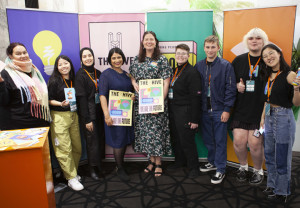Building relationships | Te whakawhanaunga
Collective action requires strong relationships based on trust and shared understanding.
On this page
How you prepare and whakawhanaungatanga connect with others will determine whether you succeed in deciding on a shared agenda, bringing the necessary people on board and creating momentum to deliver the actions you hope to see.
A good preparatory process will reveal many new insights. Early in the process you should have conversations with people who see issues from different perspectives. This will draw them in and help them understand the context for the transition.
Before you invite others to have a conversation, it’s worth thinking about your interests and the interests of your community. Take the time to consider what you hope to achieve and what experiences, perspectives and biases you might bring to the process. If you have people to whom you are accountable, it’s important to get agreement from them about exactly what it is that you’re doing. Make sure they know the objectives and scope of your transition.
Take some time to collectively draw out the connections between people, groups, problems, opportunities and anything else that is affected by the issue at the heart of your work.
Here are some questions to get started:
- What are you trying to achieve?
- What does success look like?
- Who should be involved?
It’s important to reach some broad agreement early on about the boundaries of the initiative. Otherwise, the scope can become so big that little will be achieved. During the preparatory phase, try to keep everybody’s expectations and interpretations aligned to prevent misunderstandings.
Creating Engaging Campaigns [PDF, 17.61 MB](external link) — Greenpeace
Connecting youth to government (Nationwide)
The Hive is a bridge between young people and government decision-makers. It was co-founded in 2019 by the Ministry of Youth Development and creative agency Curative, following co-design workshops with young people.

A core group of lead Hivers engages with a broader online community of young people. Policy is translated into relevant content for young people and their insights are then packaged for policy makers. The group’s 6 engagement principles are:
- Feed us (literally and metaphorically)
- Value our time
- Decode the jargon
- Create easy access
- Connect to the things we care about
- Close the loop.
The Hivers have a clear message: “Young people make up 20% of the population but are 100% of Aotearoa’s future. We believe that if government policy is better for young people, it’ll be better for our future.”
The Hive(external link) — thehive.nz
Photo credit: The Hive
Choosing collaborators
When you’re deciding whom to collaborate with, reflect carefully and consider where you may share mutual interests and what perspectives, strengths and contributions each person may offer. Recognise that some of those you approach may have concerns and might not support the process immediately. However, they may still be willing to open doors to other individuals and organisations with an interest in being informed or involved.
Here are 3 questions to keep in mind when you are reaching out to potential collaborators:
- Why might they be interested in being involved?
- What useful knowledge and skills do they have?
- Do they have further networks and relationships to build on?
As you are connecting, be aware of the range of motivations people have to join a community or organisational process. Listen to people, and decide if their intentions are aligned with what you are trying to achieve.
Ask what each person or organisation can contribute to the project. Not every person or organisation will be able to make equal contributions, but each contribution may have its own special value. Encourage all your participants to be open, honest and explicit about motivations, interests and abilities.
In cases where you cannot find sufficient alignment, you might choose to not pursue further collaboration. The core principles that you apply for your transition can guide you in these decisions.
At this point, it can be useful to identify people who could engage with your work at different levels, ranging from key champions to individuals and organisations that will not be directly involved but should be kept informed to maintain relationships and keep doors open for future collaboration.
It can also be useful to consider the key groups that may be impacted by just transitions and help to shape them. Examples include iwi tribes and hapū kin groups, community organisations, workers and unions, businesses, educators, local and central government, and intermediaries such as researchers and facilitators.
Diversity of participation is a strength. People bring different capabilities, and they must be supported and resourced to participate.
Toimata Foundation – collective impact through nationwide relationships (Nationwide)
Toimata Foundation supports over 1,600 schools, kura Māori language schools, early childhood centres and hapori communities in a long-term process of learning and taking action. Since 2001 Toimata have developed a large nationwide network of high-trust relationships. There are now over 100 agencies investing in building community capability to take action that is locally relevant and culturally grounded.
They have an emphasis on bringing people together and growing a puna mātauranga pool of knowledge so that participants can share ideas, successes, learnings and feel connected to the wider movement of change makers. They are working to extend the vision of 2 well-known programmes, Te Aho Tū Roa and Enviroschools.
This approach creates a wide range of outcomes including:
- Community resilience and interconnectedness
- Ecosystem restoration
- Caring for wai water
- Moving towards zero waste
- Authentic Tiriti partnerships
- Weaving Māori wisdoms and knowledge
- Food security and kai sovereignty
- Uptake of active transport options
- Nature connection for wellbeing
- Empowerment for people of all ages
Toimata Foundation(external link) — toimata.org.nz

Photo credit: Toimata Foundation

